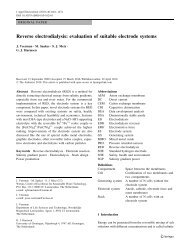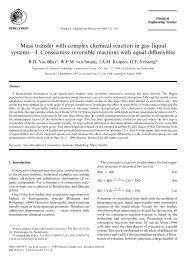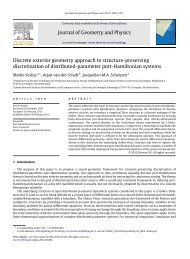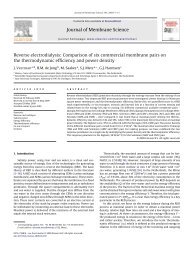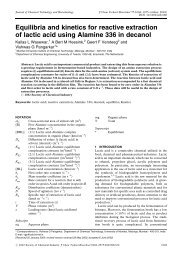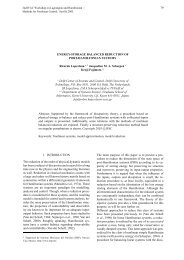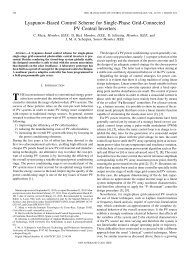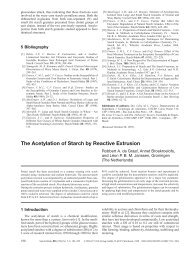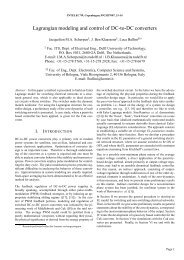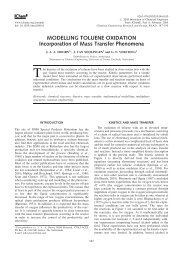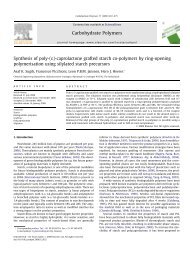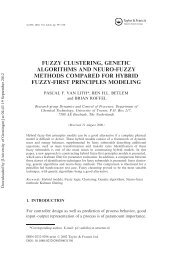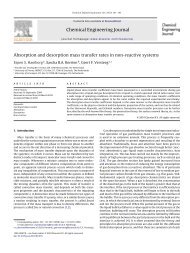Mass transfer with complex chemical reaction in gas—liquid ... - ITM
Mass transfer with complex chemical reaction in gas—liquid ... - ITM
Mass transfer with complex chemical reaction in gas—liquid ... - ITM
- No tags were found...
Create successful ePaper yourself
Turn your PDF publications into a flip-book with our unique Google optimized e-Paper software.
140 R.D. Vas Bhat et al./Chemical Eng<strong>in</strong>eer<strong>in</strong>g Science 54 (1999) 137—147Table 2Effect of diffusivity of A on the enhancement factor: K "10; K "100; K "10; k "9.7710 ms; Ha"4096Case r r r r "r (1b) (1c) E 1 0.1 1 1 1 Reversible Reversible 20.532 0.1 1 1 1 Irreversible Reversible 17.313 0.1 1 1 1 Reversible Irreversible 20.984 0.1 1 1 1 Irreversible Irreversible 17.535 0.1 1 10 1 Reversible Reversible 21.136 0.1 1 10 1 Irreversible Reversible 17.317 0.1 1 10 1 Reversible Irreversible 21.558 0.1 1 10 1 Irreversible Irreversible 17.539 0.1 0.1 0.1 1 Reversible Reversible 16.3410 0.1 0.1 0.1 1 Irreversible Reversible 19.7611 0.1 0.1 0.1 1 Reversible Irreversible 16.7512 0.1 0.1 0.1 1 Irreversible Irreversible 20.65enhancement factors (compare cases 1 and 5 and cases3 and 7). This confirms the hypothesis that higherenhancement is obta<strong>in</strong>ed due to the <strong>transfer</strong> of A <strong>in</strong> theform of more mobile species. F<strong>in</strong>ally, <strong>in</strong> order to show that this phenomenon is onlytrue for low mobility of A, the diffusivities of C andD have also been reduced (cases 9—12). As can beexpected, the enhancement factor is higher for the casewhen both <strong>reaction</strong>s are irreversible and the hypothesisis no longer valid.2.2. Diffusivity of CS<strong>in</strong>ce C is both a <strong>reaction</strong> product as well as a reactant,a variation <strong>in</strong> its diffusivity is expected to have a significanteffect on the mass <strong>transfer</strong> behaviour of the system.In order to dist<strong>in</strong>guish between the various underly<strong>in</strong>gphenomena, enhancement factors for two extreme casesof r (0.01 and 10) have been compared (Fig. 3). Thesimulations have been carried out for K " K "100and K "10. Four dist<strong>in</strong>ct regions are observed(named positions I, II, III and IV). Dimensionless concentrationprofiles of all the <strong>chemical</strong> species over thepenetration depth have been presented for each position.The correspond<strong>in</strong>g values of simulation parameters ateach of these positions are given along <strong>with</strong> the figures.2.2.1. Position IS<strong>in</strong>ce this position is before the kick-<strong>in</strong> po<strong>in</strong>t of <strong>reaction</strong>(1c), there is no production of E and F as can be seen <strong>in</strong>Fig. 4(a) and (b). From the figure it is clear that <strong>reaction</strong>(1b) is <strong>in</strong>stantaneous, <strong>in</strong>dicated by the formation of a <strong>reaction</strong>zone between A and B. Thus, near the <strong>in</strong>terface,the concentration of A is governed by the equilibriumconstant, K . At higher r (Fig. 4b), C produced by<strong>reaction</strong> (1b) is <strong>transfer</strong>red faster <strong>in</strong>to the bulk on accountof its greater mobility, thereby reduc<strong>in</strong>g the concentrationof C near the <strong>in</strong>terface. In order to ma<strong>in</strong>ta<strong>in</strong> K constant,the concentration of A near the <strong>in</strong>terface also falls.This <strong>in</strong>creases the concentration gradient of A near the<strong>in</strong>terface and, <strong>in</strong> turn, the enhancement. Conversely, forlow mobility of C [Fig. 4(a)], C formed by <strong>reaction</strong>between A and B rema<strong>in</strong>s near the <strong>in</strong>terface where it<strong>in</strong>creases the concentration of A on account of the equilibriumconstra<strong>in</strong>t. This results <strong>in</strong> a lower enhancement<strong>in</strong> the absorption of A.2.2.2. Position IIAt lower r , the reduced mobility of C prevents it fromdiffus<strong>in</strong>g <strong>in</strong>to the liquid bulk, which causes the concentrationof C near the <strong>in</strong>terface to rise [Fig. 5(a)]. Thismeans that <strong>reaction</strong> (1c) will ‘kick-<strong>in</strong>’ at correspond<strong>in</strong>glylower Hatta numbers as compared to the case <strong>with</strong>a higher r . This is clearly observed <strong>in</strong> Fig. 3 where atposition II, <strong>reaction</strong> (1c) is already <strong>in</strong>fluenc<strong>in</strong>g the mass<strong>transfer</strong> for r "0.01 while its effect is much less forr "10. This is also observed from the concentrationprofiles of E (and F) <strong>in</strong> Fig. 5(a) and (b). For a lowmobility of C (r "0.01), C formed [via <strong>reaction</strong> (1b)]rema<strong>in</strong>s near the <strong>in</strong>terface where it is available for <strong>reaction</strong><strong>with</strong> A [via <strong>reaction</strong> 1(c)]. Due to the high concentrationof C, the absorption rate of A is very high as well,lead<strong>in</strong>g to large enhancement. For a high mobility ofC(r "10), C can diffuse away from the <strong>in</strong>terface so thatits <strong>in</strong>terfacial concentration is low (as compared to r "0.01) and, hence, the absorption rate of A is also low.2.2.3. Position IIIOn <strong>in</strong>creas<strong>in</strong>g the Hatta number from position II toposition III (Fig. 3), there is an <strong>in</strong>crease <strong>in</strong> enhancementdue to the <strong>reaction</strong> between C and A via <strong>reaction</strong> (1c).For a low r , C is formed by <strong>reaction</strong> (1b) away from the<strong>in</strong>terface. A fraction of this C formed diffuses towards the<strong>in</strong>terface where it reacts <strong>with</strong> A. At lower Hatta numbers(closer to position II), the diffusion rate is sufficient tosupply <strong>reaction</strong> (1c). As the Hatta number is <strong>in</strong>creased



